Abstract
The slurry aluminizing process is widely employed to enhance the oxidation and corrosion resistance of nickel-based superalloys used in high-temperature environments such as gas turbines and aerospace engines. This study investigates the effects of the concentration of Al vapors in the reactor chamber and the initial slurry layer thickness on the microstructure, chemical composition, and phase composition of aluminide coatings. Coatings were manufactured on Ni-based superalloy substrates using CrAl powders as an aluminum source and chloride- and fluoride-based activator salts. The effect of the initial thickness of the slurry layer was studied by varying the amount of deposited slurry in terms of mgslurry/cm2sample (with constant mgslurry/cm3chamber). The microstructure and phase composition of the produced aluminide coatings were evaluated by SEM, EDS, and XRD analysis. Slurry thickness can affect concentration gradients during diffusion, and the best results were obtained with an initial slurry amount of 100 mgslurry/cm2sample. The effect of the Al vapor phase in the reaction chamber was then investigated by varying the mgslurry/cm3chamber ratio while keeping the slurry layer thickness constant at 100 mgslurry/cm2sample. This parameter influences the amount of Al at the substrate surface before the onset of solid-state diffusion, and the best results were obtained for a 6.50 mgslurry/cm3chamber ratio with the formation of 80 µm coatings (excluding the interdiffusion zone) with a β-NiAl phase throughout the thickness. To validate process flexibility, the same parameters were successfully applied to produce platinum-modified aluminides with a bi-phasic ζ-PtAl2 and β-(Ni,Pt)Al microstructure.
1. Introduction
Aluminide coatings are widely used in the energy production and aeronautical industry to protect nickel-based superalloy components in the hot sections of gas turbine engines against high-temperature oxidation and hot corrosion phenomena [1,2,3]. These are typically produced by exposing the nickel-based superalloy to an aluminum-rich source, either in solid or gaseous form, at elevated temperatures. During this process, aluminum atoms diffuse into the surface of the substrate and form an intermetallic layer primarily composed of the β-NiAl phase, which offers effective resistance to oxidation and corrosion [4]. When exposed to high temperatures, β-NiAl based aluminides undergo the selective oxidation of Al, leading to the formation of a dense, uniform, and adherent α-Al2O3 scale that protects the underlying layers from further oxidation [4,5,6,7].
NiAl-based aluminide coatings can be manufactured using several methods, such as chemical vapor deposition (CVD) [8,9], pack cementation [10,11], hot dipping [12,13], and slurry aluminizing [14,15,16]. In CVD and pack cementation, the aluminizing process occurs through the gas transportation of Al from metallic precursors and solid-state diffusion mechanisms [17]. According to the aluminum activity during the process, aluminide coatings can be divided into two categories based on the process temperature and chemical activity of the species involved: in high-activity processes, coatings grow by the inward diffusion of aluminum, and brittle Al-rich phases form, so the β-NiAl phase is obtained only after subsequent annealing at high temperatures; in low-activity processes, the Ni from the base superalloy diffuses outwards and quasi-stoichiometric NiAl can be obtained directly during aluminizing [18]. High-activity aluminide coatings are typically formed using a powder pack or slurry that contains pure aluminum, which exhibits unit thermodynamic activity. The process is conducted at relatively low temperatures, generally ranging from 700 °C to 900 °C [19]. In contrast, the low-activity aluminizing process utilizes an aluminum source of reduced chemical potential, typically binary Al-based alloys (e.g., alloying Al with Cr [20,21,22], Fe [23], or Ni [24]). Due to the lower vapor pressure of aluminum halides generated in this system, higher processing temperatures (usually between 1000 °C and 1150 °C) are required to sustain effective coating formation.
The slurry aluminizing method is similar to pack cementation, but powders containing the metal source and activators required for the gas transportation of Al are mixed with an organic binder to obtain a slurry that can be applied locally, with several advantages in terms of cost and ease of application. The method generally operates under high aluminum activity [25,26,27]; however, using Al alloys (typically CrAl alloys) as the aluminum source can lower the activity level [28]. This second strategy, however, still requires an additional annealing step after aluminizing, resulting in higher coating times, but some Cr can diffuse into the coating, increasing its resistance and high-temperature performances [29].
The essential steps of slurry aluminizing include (i) the generation of vapors containing aluminum or other constituents of the coating from the reaction between the activator salts and the Al-containing metallic source; (ii) the transportation of Al vapors towards the Ni-based superalloy substrate; (iii) a reaction with the substrate surface to form NixAly compounds; and (iv) solid-state diffusion to eventually obtain the NiAl phase. The same method can be used for the manufacturing of Pt-modified aluminides, well-known to further improve high-temperature resistance [30,31,32,33,34]. The only additional steps required are the initial deposition of a thin Pt layer onto the superalloy and a pre-aluminizing diffusion heat treatment [35].
The quality and performance of the resulting aluminide coating are influenced by several key factors [36]:
The slurry composition: The proportion of aluminum powder and binder within the slurry directly affects the coating’s final characteristics, including its thickness, homogeneity, and adhesion to the substrate.
The slurry layer thickness: The actual thickness of the applied slurry can significantly influence the coating’s microstructure as it determines the initial amount of aluminum available for diffusion.
The slurry load in the reaction chamber: The amount of reagents present in the reaction chamber directly affects Al transport to the substrate, thereby affecting the phase composition and microstructure of the coating.
Heat treatment parameters: The temperature and duration of the heat treatment are critical for ensuring sufficient aluminum diffusion into the substrate and for achieving the desired intermetallic phases and coating integrity.
Under the same conditions of slurry composition and heat treatment, the microstructure of aluminide coatings is strongly affected by the concentration of Al vapors in the reactor chamber and by the initial slurry layer thickness. Both parameters affect the amount of Al that initially reacts with the superalloy, thus affecting the final phase composition of the coating and, consequently, their oxidation resistance.
Despite its advantages over other techniques, the slurry aluminizing method is not standardized yet, and, to the author’s knowledge, an optimization of the process to increase its efficiency and flexibility is still required. To this aim, this work investigates the influence of (i) the Al vapor concentration in the reactor chamber and (ii) the initial slurry layer thickness on the manufacturing of aluminide coatings. The used slurry comprised CrAl powders as an aluminum source and both chloride- and fluoride-based activator salts. The parameters were optimized to obtain a coating with a homogeneous β-NiAl microstructure across the thickness to define a process that can be used for the manufacturing of both standard and Pt-modified aluminides.
2. Materials and Methods
2.1. Coating Preparation
Half-disk-shaped specimens with a 2.54 mm diameter made of single-crystal nickel-based superalloys were used as substrates. The nominal composition of the superalloy is reported in Table 1 [37]. All chemicals used for the manufacturing of coatings were of analytic grade, purchased from Sigma-Aldrich (Merck KGaA, Darmstadt, Germany).

Table 1.
The nominal composition of the nickel-based superalloy used as substrate 1 [37].
Aluminide coatings were manufactured by the slurry aluminizing method using chloride- and fluoride-based activator salts and CrAl intermetallic powders (average size of 50 µm) as the aluminum source. A scanning electron microscopy–backscattered electron (SEM-BSE) micrograph and X-ray diffraction (XRD) analysis of the as-received CrAl powder are reported in Figure 1a and b, respectively. All peaks in the XRD spectra can be attributed to the Al8Cr5 intermetallic (JCPDS 29-0015), consistent with the 45 wt.% Al and 55 wt.% Cr nominal composition.
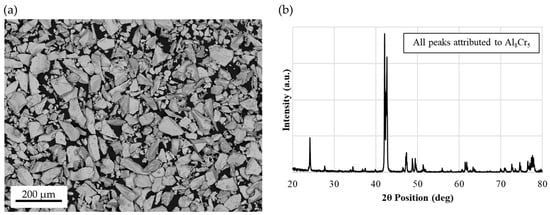
Figure 1.
SEM micrograph (a) and XRD spectra (b) of as-received CrAl powders.
The slurry aluminizing process is schematized in Figure 2. Prior to slurry deposition, the superalloy was sandblasted with corundum mesh 80 to guarantee the same surface finish and promote slurry adhesion. To prepare the slurry, a chloride-based activator salt, a fluoride-based activator salt, and CrAl powder were added to a beaker containing a polymeric binder and underwent magnetic stirring for at least 30 min (Figure 2a). After that, the slurry was poured into an Iwata G3 airbrush (Anest Iwata Corporation, Yokohama, Japan) at room temperature (Figure 2b) and sprayed onto the nickel-based superalloy employed as a substrate at a 0.3 MPa working pressure and 45° incidence angle (Figure 2c). Between each pass, the slurry-coated samples were dried in an oven at 65 °C for 1 h; once the desired slurry amount was deposited, the samples were heated at 150 °C for 3 h.
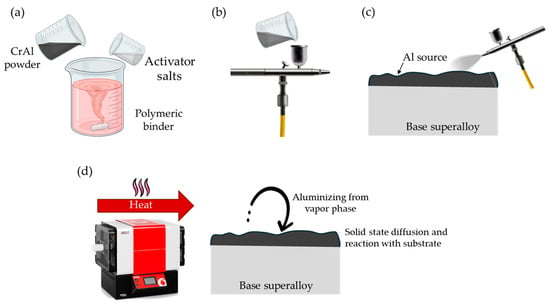
Figure 2.
A schematic representation of the main steps of the slurry aluminizing process: (a) slurry preparation; (b) pouring of the slurry in an airbrush; (c) spraying on the base superalloy; (d) aluminizing heat treatment.
Eventually, aluminizing was performed by heat-treating the samples in a Carbolite-Gero tube furnace (Carbolite-Gero, Sheffield, UK) under inert atmosphere with the following schedule: 4 h at 1100 °C under a continuous 0.5 L/min Ar flux and 6 h at 900 °C under a 2 L/min Ar flux (Figure 2d) [38]. The first dwell allowed for aluminization through Al reaction with the substrate, and the second dwell promoted interdiffusion and the formation of the desired protective phases.
To optimize the process, the effects of the amount of slurry deposited on the substrate (in terms of mgslurry/cm2sample) and of the amount of slurry present in the reaction chamber (in terms of mgslurry/cm3chamber) were investigated. First, quantities equal to 80, 100, 120, and 150 mgslurry/cm2sample were studied, and the best results were selected in terms of β-NiAl formation and distribution through the thickness of the samples. Once the best amount of deposited slurry was selected, the influence of the slurry amount in the reaction chamber was studied, varying between 1.63, 3.25, 6.50, and 13.0 mgslurry/cm3chamber, and the best results were selected in terms of the microstructure and β-NiAl distribution.
For the manufacturing of Pt-modified aluminides, a 4.5 µm thick Pt layer was deposited onto the base superalloy by means of electroless deposition. Prior to deposition, superalloy samples were sandblasted with corundum mesh 80 at a pressure of 6.2 bar and a blast distance of 100 mm. Each sample received 10 passes to uniformly increase surface roughness (Ra = 3.877 ± 0.312 μm). Higher surface roughness promotes metal deposition by increasing surface energy [39] and enhances adhesion via mechanical interlocking [40]. After sandblasting, the samples were ultrasonically cleaned in acetone using an Elmasonic S 30 (H) bath (37 kHz frequency, 80 W effective power) (Elma Schmidbauer GmbH, Singen, Germany) for 10 min to remove any sandblasting residue. Eventually, they were rinsed with deionized water just before immersion in the plating bath.
After Pt deposition, the samples underwent a pre-aluminizing diffusion heat treatment at 1100 °C for 1 h under a vacuum to promote Pt dilution in the superalloy [41]. Finally, slurry aluminizing was performed according to the optimized procedure.
2.2. Coating Characterization
The changes in coating microstructure according to the manufacturing procedure were studied using a Field Emission Gun–Scanning Electron Microscope (FEG-SEM) Tescan Mira3 (Tescan, Brno, Czech Republic) equipped with an Edax Octane Elect Energy Dispersive X-Ray Spectroscopy (EDS) system (Edax/Ametek Inc., Berwyn, PA, USA). Edax Team v.5 software was used for elemental analysis.
Samples were prepared for cross-sectional observation by mounting in epoxy resin (EpoThin 2, Buehler Ltd., Lake Bluff, IL, USA) and subsequent polishing with SiC papers (P400 grit to P1200 grit) and water-based diamond suspensions (up to 1 μm finishing) (Buehler Ltd., Lake Bluff, IL, USA).
The crystalline phases present in the coatings were investigated by X-ray diffraction (XRD) analysis with a Philips X’Pert diffractometer (PANalytical BV, Almelo, The Netherlands) operating at 40 KV and 40 mA with CuKα radiation. Scan range of acquisition was 20–80° (2θ), with a feed step of 0.02° and acquisition time of 2 s.
3. Results
3.1. Aluminide Coatings
Figure 3 shows the cross-sectional SEM micrograph of the slurry layer (120 mg/cm2) after the drying step at 150 °C for 3 h, along with the EDS map. The slurry layer appears uniform across the sample, with a homogeneous distribution of CrAl particles. The F signal arises from the fluorine of the fluorine-based activator salt and is present all along the sample cross-section, though unevenly.
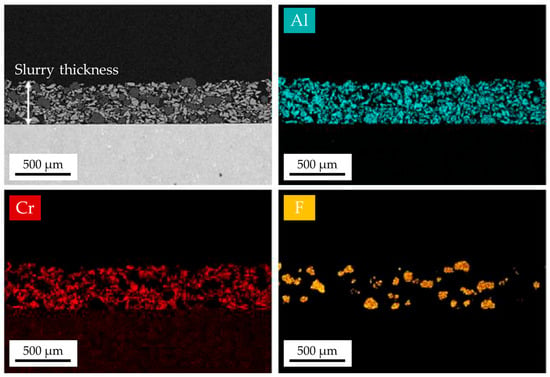
Figure 3.
SEM-BSE micrograph and EDS map of slurry layer after drying at 150 °C for 3 h.
The optimization of the slurry aluminizing method was first addressed by evaluating the influence of the initial slurry layer thickness. The samples were prepared with slurry loadings of 80, 100, 120, and 150 mgslurry/cm2sample while keeping the overall slurry concentration in the reaction chamber constant at 3.25 mgslurry/cm3chamber. Cross-sectional micrographs of the resulting coatings are presented in Figure 4. For samples with initial slurry layers of 80, 100, and 120 mgslurry/cm2sample, the coating thicknesses were nearly identical, measuring approximately 92 ± 3 µm, with an interdiffusion zone (IDZ) of 24 ± 2 µm. However, a significant increase in both coating thickness (115 ± 4 µm) and IDZ thickness (32 ± 3 µm) was observed when the slurry layer reached 150 mgslurry/cm2sample. These findings align with the observations by Li et al. [36], who suggested that excessively thick slurry layers can accelerate Ni–Al diffusion kinetics, thus producing thicker coatings. Regardless of the slurry layer thickness, all coatings exhibited the typical inward-grown aluminide microstructure, characterized by Cr-rich precipitates in the outer region and finely dispersed Ta/W-rich precipitates throughout the coating thickness, in agreement with previous work conducted by Goward and Boone [24]. These refractory elements originate from the underlying superalloy, given their known mobility at temperatures above 1000 °C [42], and then precipitate in the β-NiAl layer, given their low solubility in this phase [43]. Some Al2O3 particles can be observed in the outermost region of the coatings (as pointed by the arrow in Figure 4c), which are residues of the sandblasting procedure. These also act as markers of the initial surface of coatings, confirming the inward growth of the aluminide.
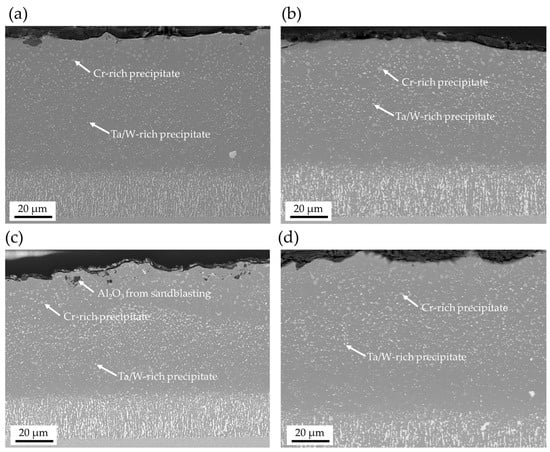
Figure 4.
Cross-sectional micrographs of coatings deposited with 80 mgslurry/cm2sample (a), 100 mgslurry/cm2sample (b), 120 mgslurry/cm2sample (c), and 150 mgslurry/cm2sample (d).
However, notable differences were observed in the Al/Ni atomic ratio along the coating depth, as determined by EDS analysis (Figure 5b), while a representative micrograph is shown in Figure 5a. This ratio plays a critical role in determining the resulting matrix phase: Al/Ni ratios exceeding 1.2 can lead to the formation of the brittle Ni2Al3 intermetallic, while ratios below 0.7 favor the development of Ni3Al, which compromises oxidation resistance. The amount of deposited slurry influences the concentration gradients that develop during the aluminizing process. If the aluminum content is too high, as in the case of 80 and 120 mgslurry/cm2sample, there may not be enough time during the diffusion heat treatment for NiAl to form uniformly across the coating, leading to aluminum-rich outer layers. Conversely, the sample coated with 150 mgslurry/cm2sample showed a deficiency in aluminum in the inner region, likely due to ineffective Al transport caused by the excessive slurry thickness. Thus, the optimal initial slurry amount was determined to be 100 mgslurry/cm2sample as it yielded a uniform Al/Ni ratio compatible with β-NiAl phase formation throughout the coating.

Figure 5.
(a) Typical cross-sectional micrograph of aluminized samples; (b) Al/Ni atomic ratio as function of distance from surface (depth) for coatings manufactured with different mgslurry/cm2sample ratios.
Next, the influence of slurry concentration within the reaction chamber was explored while maintaining a constant initial slurry thickness of 100 mgslurry/cm2sample. The Al/Ni atomic ratio profiles across the coating depth for coatings produced with 1.63, 3.25, 6.50, and 13.0 mgslurry/cm3chamber are shown in Figure 6. Optimal results were observed for 3.25 and 6.50 mgslurry/cm3chamber. At 1.63 mgslurry/cm3chamber, the coatings exhibited an Al/Ni profile consistent with NiAl only near the outer surface, while the matrix gradually transitioned to Ni3Al toward the IDZ. On the other hand, excessive Al availability at 13.0 mgslurry/cm3chamber led to higher Al/Ni ratios throughout the coating, indicative of the presence of Ni2Al3, a brittle and non-protective phase. These observations can be attributed to the increase in the Al vapor concentration with an increasing slurry content in the chamber, which affects the initial Al accumulation at the substrate surface before solid-state diffusion begins [44], promoting the formation of Al-rich phases during heat treatment.
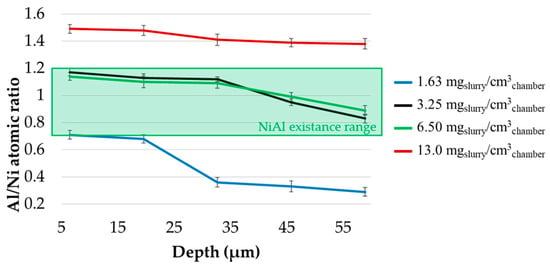
Figure 6.
The Al/Ni atomic ratio as a function of the distance from the surface (depth) for coatings manufactured with different mgslurry/cm3chamber ratios.
The corresponding microstructures are shown in Figure 7. Backscattered electron (BSE) imaging reveals that the coating produced with 1.63 mgslurry/cm3chamber contains light gray phases, which correspond to Ni3Al. This phase was not observed in coatings produced with a higher slurry content. As the slurry concentration increased, a slight thickening of the coatings was noted, along with the development of more pronounced outer zones enriched in CrₓAlᵧ intermetallic compounds due to the reaction between chromium from the substrate and the abundant aluminum at the superalloy surface [45]. These results further support the conclusion that an increased mgslurry/cm3chamber ratio enhances aluminum availability at the surface, facilitating the formation of aluminum-rich intermetallics as diffusion progresses.
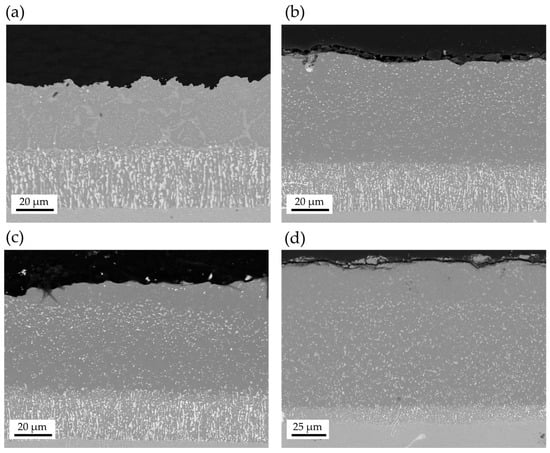
Figure 7.
SEM-BSE cross-sectional micrographs of aluminide coatings obtained with (a) 1.63 mgslurry/cm3chamber, (b) 3.25 mgslurry/cm3chamber, (c) 6.50 mgslurry/cm3chamber, and (d) 13.0 mgslurry/cm3chamber.
Based on the above findings, 6.50 mgslurry/cm3chamber was selected as the optimal slurry amount in the reaction chamber. This condition provides a coating with an Al/Ni profile comparable to that obtained with 3.25 mgslurry/cm3chamber while offering increased coating thickness and the possibility of treating larger surface areas per batch, thereby improving process efficiency.
The phase composition of the coatings was confirmed by XRD analysis. Figure 8a displays the diffraction spectra for coatings produced with 80, 100, and 150 mgslurry/cm2sample. All samples primarily consist of the NiAl phase, but a distinct Ni2Al3 signal is detected in the 80 mgslurry/cm2sample coating, in line with the EDS findings shown in Figure 5b. CrₓAlᵧ intermetallic peaks, typical of inward-grown coatings, are present in all samples. Additionally, AlTi2 peaks appear, resulting from titanium diffusion from the substrate. The spectra for coatings produced with different slurry chamber concentrations are reported in Figure 8b. Coatings with 1.63 mgslurry/cm3chamber exhibited a biphasic structure of NiAl and Ni3Al, confirming insufficient Al vapor generation for forming a uniform NiAl layer. Conversely, at an excessively high slurry content, Ni2Al3 and NiAl3 phases were detected, indicating an overabundance of aluminum and the formation of brittle, non-protective intermetallics. Only NiAl and AlCr2 peaks were observed in the sample processed at 6.50 mgslurry/cm3chamber, confirming its capability to develop a protective α-Al2O3 scale under high-temperature conditions.
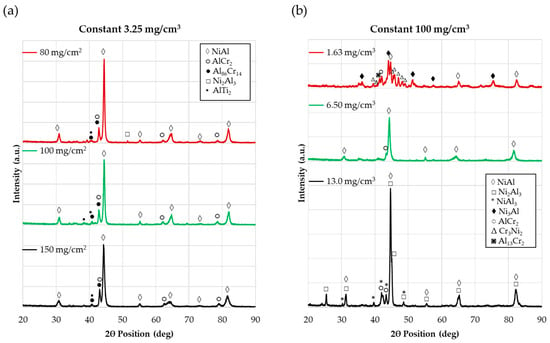
Figure 8.
The XRD spectra of aluminide coatings obtained by varying the mgslurry/cm2sample (a) and mgslurry/cm3chamber (b) ratios.
3.2. Manufacturing of Pt-Aluminides
To further validate the flexibility and applicability of the optimized slurry aluminizing process for high-demand applications, platinum-modified aluminide coatings were manufactured. A 4.5 µm thick Pt layer was first deposited onto the superalloy substrate, followed by a pre-aluminizing diffusion heat treatment prior to slurry application. The cross-sectional micrograph of the resulting Pt–aluminide coating is shown in Figure 9a. The overall coating thickness was measured to be 98 ± 4 µm, comprising an interdiffusion zone (IDZ) of 24 ± 3 µm and an outer biphasic layer of 29 ± 3 µm. A detailed view of the microstructure in the outer biphasic region is provided in Figure 9b, along with the corresponding EDS analysis of the constituent phases. The brighter phase corresponds to ζ-PtAl2, which likely incorporates minor amounts of Cr and Ni, as indicated by the quantitative EDS data in Table 2. The brightness of individual ζ-phase grains appears to decrease with increasing Ni and Cr contents, reflecting local compositional variations. In contrast, the light gray phase in the outer layer corresponds to β-(Ni,Pt)Al, with a low amount of alloying elements in the solid solution, as indicated by the EDS quantitative analysis in Table 3. Small, bright, well-dispersed dot-like precipitates are observed throughout the coating, particularly along grain boundaries. These precipitates are rich in Ta and W and originate from the underlying superalloy, which is rich in these refractory elements. Despite the higher bulk W content in the superalloy, the EDS analysis suggests that the precipitates are predominantly composed of Ta. This is attributed to the much higher interdiffusion coefficient of Ta compared to W, which is about one order of magnitude greater, at typical coating temperatures [42].
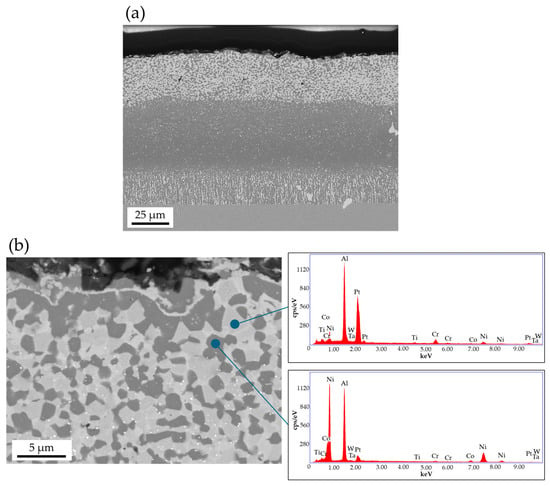
Figure 9.
(a) A cross-sectional micrograph of the Pt-aluminide coating obtained with the optimized slurry method and (b) a high-magnification view of the microstructure in the outer biphasic region with EDS analysis.

Table 2.
A quantitative EDS analysis of the ζ-PtAl2 phase located in the outer region of the Pt–aluminide coating.

Table 3.
A quantitative EDS analysis of the β-(Ni,Pt)Al phase located in the outer region of the Pt–aluminide coating.
The presence of Cr-rich precipitates is also observed in the coating. This may be explained by the limited solubility of Cr in the plain β-NiAl phase [46]. In Pt-modified coatings, high Pt activity can promote the formation of PtCr intermetallic phases, as reported in [47]. Over prolonged high-temperature exposures, these phases may undergo transformation and result in localized Cr enrichment or secondary precipitation.
The elemental concentration profiles of Ni, Al, and Pt across the coating (expressed in atomic percent) are plotted in Figure 10. Both the Pt and Al concentrations are elevated in the outermost region, consistent with the observed biphasic ζ-PtAl2 and β-(Ni,Pt)Al microstructure. Crucially, the Al concentration does not exhibit a sharp drop before the IDZ. At a depth of 60 µm from the surface, an Al/Ni atomic ratio of approximately 0.8 is still present, indicating that the coating remains within the compositional range of β-NiAl.
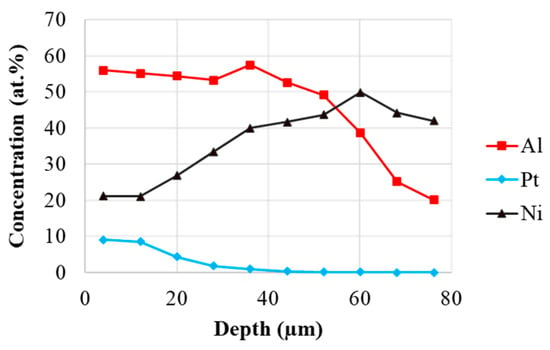
Figure 10.
Elemental concentration profiles of Ni, Al, and Pt across thickness of Pt–aluminide coating.
Further confirmation of the phase constitution was obtained via XRD, as shown in Figure 11a. The diffractogram reveals the presence of both PtAl2 (JCPDS 65-2983) and NiAl peaks (JCPDS 20-0019), consistent with the biphasic microstructure of the outer coating layer. The incorporation of platinum into the β-NiAl lattice results in a distinct shift in the diffraction peaks to lower 2θ angles compared to those of pure β-NiAl (2θ = 44.3678°), consistent with previous findings [42,48]. This shift is attributed to the distortion of lattice parameters caused by the substitutional incorporation of Pt atoms at Ni sites within the NiAl crystal structure. It is a well-established phenomenon that the incorporation of foreign atoms into a crystal lattice induces local strains and stresses, the magnitude of which depends on the atomic size difference between the original and the incorporated species. In this case, the atomic radii of Ni and Pt are 124.0 pm and 138.5 pm, respectively [49]. This considerable size mismatch leads to a distortion of the lattice, which manifests as an increase in the interplanar distances in the lattice and as a measurable peak shift in the XRD spectrum. These findings, together with the relatively high Pt amount detected by EDS analysis in correspondence with NiAl grains, validate the substitutional nature of Pt incorporation and provide indirect confirmation of its homogeneous integration into the β-NiAl matrix. However, it should also be pointed out that such peak shift is addressed to a general increase in lattice parameters, which can also be attributed to a deviation from the exact phase stoichiometry toward the enrichment of the phase atom with a larger size, i.e., Al (with an atomic radius equal to 143 pm [50]). Therefore, the peak shift can be attributed to the combined effect of Pt substitution and to the formation of a hyperstoichiometric (Al-rich) NiAl phase. Similarly, the PtAl2 peaks are also shifted relative to those of the stoichiometric phase, likely due Al enrichment within the phase homogeneity region, as previously observed in studies such as [42]. Details of the peak shift are reported in Figure 11b. A minor peak corresponding to Al5Cr is also detected and is attributed to residual particles originating from the aluminizing slurry.
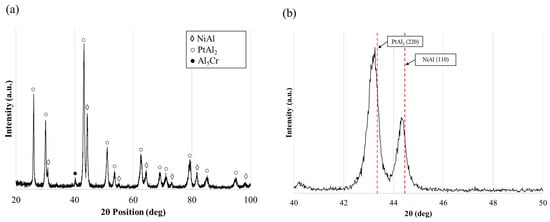
Figure 11.
(a) XRD diffractogram of Pt–aluminide coating obtained with optimized slurry method and (b) details of NiAl and PtAl2 peak shift.
4. Conclusions
This study investigated the slurry aluminizing process for nickel-based superalloys, focusing on optimizing the initial slurry thickness on the substrate and the aluminum vapor concentration in the reaction chamber to achieve the manufacturing of a homogeneous β-NiAl coating.
It was demonstrated that the best results are obtained with an amount of slurry deposited on the substrate equal to 100 mgslurry/cm2sample, which ensures a balanced Al/Ni atomic ratio across the coating thickness, and an amount of slurry in the reaction chamber of 6.50 mgslurry/cm3chamber, offering sufficient aluminum availability for diffusion while avoiding the formation of brittle intermetallic phases like Ni2Al3. Cross-sectional micrographs and an XRD analysis revealed that the coatings produced under optimal conditions exhibited a uniform β-NiAl matrix, with CrxAly intermetallics in the outer regions and small heavy element precipitates typical of inward-grown aluminides. Conversely, different slurry concentrations led to undesirable phases, such as Ni2Al3 and Ni3Al, which can compromise the coating’s protective capabilities. The process demonstrated adaptability for the manufacturing of platinum-modified aluminides with a bi-phasic ζ-PtAl2 and β-(Ni,Pt)Al microstructure, known for superior high-temperature oxidation and corrosion resistance. These findings support the scalability and industrial applicability of the slurry aluminizing method, providing a cost-effective and efficient process for the manufacturing of coatings for high-performance applications in the aerospace and energy production industries.
Author Contributions
Conceptualization, G.P.; methodology, G.P. and V.G.; software, G.P.; validation, C.B. and L.P.; formal analysis, V.G. and R.B.; investigation, G.P., V.G. and M.C.; resources, E.S. and C.B.; data curation, G.P., M.C. and R.B.; writing—original draft preparation, G.P.; writing—review and editing, V.G., R.B. and L.P.; visualization, G.P. and L.P.; supervision, E.S. and C.B.; project administration, E.S.; funding acquisition, E.S. and C.B. All authors have read and agreed to the published version of the manuscript.
Funding
This research received no external funding.
Institutional Review Board Statement
Not applicable.
Informed Consent Statement
Not applicable.
Data Availability Statement
The data presented in this study are available upon request from the corresponding author due to institutional policies.
Conflicts of Interest
Authors Virgilio Genova and Erica Scrinzi were employed by the company Nuovo Pignone Tecnologie Srl. The remaining authors declare that the research was conducted in the absence of any commercial or financial relationships that could be construed as a potential conflict of interest.
References
- Pomeroy, M.J. Coatings for Gas Turbine Materials and Long Term Stability Issues. Mater. Des. 2005, 26, 223–231. [Google Scholar] [CrossRef]
- Darolia, R. Thermal Barrier Coatings Technology: Critical Review, Progress Update, Remaining Challenges and Prospects. Int. Mater. Rev. 2013, 58, 315–348. [Google Scholar] [CrossRef]
- Guo, L.; He, W.; Chen, W.; Xue, Z.; He, J.; Guo, Y.; Wu, Y.; Gao, L.; Li, D.; Zhang, Z.; et al. Progress on High-Temperature Protective Coatings for Aero-Engines. Surf. Sci. Technol. 2023, 1, 6. [Google Scholar] [CrossRef]
- Genova, V.; Pedrizzetti, G.; Paglia, L.; Marra, F.; Bartuli, C.; Pulci, G. Diffusion Aluminide Coating Modified via Electroless Nickel Plating for Ni-Based Superalloy Protection. Surf. Coat. Technol. 2022, 439, 128452. [Google Scholar] [CrossRef]
- Kopec, M. Recent Advances in the Deposition of Aluminide Coatings on Nickel-Based Superalloys: A Synthetic Review (2019–2023). Coatings 2024, 14, 630. [Google Scholar] [CrossRef]
- Kopec, M. Effect of Aluminide Coating Thickness on High-Temperature Fatigue Response of MAR-M247 Nickel-Based Superalloy. Coatings 2024, 14, 1072. [Google Scholar] [CrossRef]
- Barwinska, I.; Kopec, M.; Kukla, D.; Łazińska, M.; Sitek, R.; Kowalewski, Z.L. Effect of Aluminizing on the Fatigue and High-Temperature Corrosion Resistance of Inconel 740 Nickel Alloy. JOM 2023, 75, 1482–1494. [Google Scholar] [CrossRef]
- Pedraza, F.; Gómez, C.; Carpintero, M.C.; Hierro, M.P.; Pérez, F.J. On the Aluminisation of Stainless Steel by CVD in Fluidised Beds. Surf. Coat. Technol. 2005, 190, 223–230. [Google Scholar] [CrossRef]
- Zhang, Y.; Pint, B.A.; Cooley, K.M.; Haynes, J.A. Formation of Aluminide Coatings on Fe-Based Alloys by Chemical Vapor Deposition. Surf. Coat. Technol. 2008, 202, 3839–3849. [Google Scholar] [CrossRef]
- Xiang, Z.D.; Burnell-Gray, J.S.; Datta, P.K. Aluminide Coating Formation on Nickel-Base Superalloys by Pack Cementation Process. J. Mater. Sci. 2001, 36, 5673–5682. [Google Scholar] [CrossRef]
- Zhao, Y.; Zhou, K.; Xin, X.; Zeng, X.; Guo, X.; Qiao, Y. Microstructure and Oxidation Behavior of the Aluminized Coating on K447A Nickel-Based Superalloy Prepared by AlF3-Activated Pack Cementation. Surf. Coat. Technol. 2025, 510, 132236. [Google Scholar] [CrossRef]
- Wang, C.-J.; Chen, S.-M. Microstructure and Cyclic Oxidation Behavior of Hot Dip Aluminized Coating on Ni-Base Superalloy Inconel 718. Surf. Coat. Technol. 2006, 201, 3862–3866. [Google Scholar] [CrossRef]
- Glasbrenner, H.; Wedemeyer, O. Comparison of Hot Dip Aluminised F82H-Mod. Steel after Different Subsequent Heat Treatments. J. Nucl. Mater. 1998, 257, 274–281. [Google Scholar] [CrossRef]
- Kepa, T.; Pedraza, F.; Rouillard, F. Intermetallic Formation of Al-Fe and Al-Ni Phases by Ultrafast Slurry Aluminization (Flash Aluminizing). Surf. Coat. Technol. 2020, 397, 126011. [Google Scholar] [CrossRef]
- Bakhtiary, O.; Sarraf, S.; Soltanieh, M. Microstructure Evaluation of Si-Modified Aluminide Coatings on IN625 Deposited by Slurry Aluminizing Process. Surf. Coat. Technol. 2025, 495, 131592. [Google Scholar] [CrossRef]
- Pedraza, F.; Boulesteix, C.; Proy, M.; Lasanta, I.; de Miguel, T.; Illana, A.; Pérez, F.J. Behavior of Slurry Aluminized Austenitic Stainless Steels under Steam at 650 and 700 °C. Oxid. Met. 2017, 87, 443–454. [Google Scholar] [CrossRef]
- Bozza, F.; Bolelli, G.; Giolli, C.; Giorgetti, A.; Lusvarghi, L.; Sassatelli, P.; Scrivani, A.; Candeli, A.; Thoma, M. Diffusion Mechanisms and Microstructure Development in Pack Aluminizing of Ni-Based Alloys. Surf. Coat. Technol. 2014, 239, 147–159. [Google Scholar] [CrossRef]
- Sarraf, S.H.; Soltanieh, M.; Rastegari, S. Reactive air aluminizing of a nickel-based superalloy (IN738LC): Coating formation mechanism. Surf. Coat. Technol. 2023, 456, 129229. [Google Scholar] [CrossRef]
- Bianco, R.; Rapp, R.A. Pack Cementation Diffusion Coatings. In Metallurgical and Ceramic Protective Coatings; Springer: Dordrecht, The Netherlands, 1996; pp. 236–260. [Google Scholar]
- Wang, Y.Q.; Sayre, G. Factors Affecting the Microstructure of Platinum-Modified Aluminide Coatings during a Vapor Phase Aluminizing Process. Surf. Coat. Technol. 2009, 203, 1264–1272. [Google Scholar] [CrossRef]
- Grüters, J.; Galetz, M.C. Influence of Thermodynamic Activities of Different Masteralloys in Pack Powder Mixtures to Produce Low Activity Aluminide Coatings on TiAl Alloys. Intermetallics 2015, 60, 19–27. [Google Scholar] [CrossRef]
- Benoist, J.; Badawi, K.F.; Malié, A.; Ramade, C. Microstructure of Pt Modified Aluminide Coatings on Ni-Based Superalloys without Prior Pt Diffusion. Surf. Coat. Technol. 2005, 194, 48–57. [Google Scholar] [CrossRef]
- Voudouris, N.; Christoglou, C.; Angelopoulos, G.N. Formation of Aluminide Coatings on Nickel by a Fluidised Bed CVD Process. Surf. Coat. Technol. 2001, 141, 275–282. [Google Scholar] [CrossRef]
- Goward, G.W.; Boone, D.H. Mechanisms of Formation of Diffusion Aluminide Coatings on Nickel-Base Superalloys. Oxid. Met. 1971, 3, 475–495. [Google Scholar] [CrossRef]
- Rannou, B.; Bouchaud, B.; Balmain, J.; Bonnet, G.; Pedraza, F. Comparative Isothermal Oxidation Behaviour of New Aluminide Coatings from Slurries Containing Al Particles and Conventional Out-of-Pack Aluminide Coatings. Oxid. Met. 2014, 81, 139–149. [Google Scholar] [CrossRef]
- Galetz, M.C.; Montero, X.; Mollard, M.; Günthner, M.; Pedraza, F.; Schütze, M. The Role of Combustion Synthesis in the Formation of Slurry Aluminization. Intermetallics 2014, 44, 8–17. [Google Scholar] [CrossRef]
- Grégoire, B.; Bonnet, G.; Pedraza, F. Mechanisms of Formation of Slurry Aluminide Coatings from Al and Cr Microparticles. Surf. Coat. Technol. 2019, 359, 323–333. [Google Scholar] [CrossRef]
- Montero, X.; Galetz, M.C.; Schütze, M. Low-Activity Aluminide Coatings for Superalloys Using a Slurry Process Free of Halide Activators and Chromates. Surf. Coat. Technol. 2013, 222, 9–14. [Google Scholar] [CrossRef]
- Conti, M.; Paglia, L.; Genova, V.; Pedrizzetti, G.; Baiamonte, L.; Marra, F. The Effects of Deposition Parameters on the Properties of NiCr Coatings Obtained by Electroless Plating. Chem. Eng. Trans. 2023, 100, 427–432. [Google Scholar] [CrossRef]
- Das, D.K. Microstructure and High Temperature Oxidation Behavior of Pt-Modified Aluminide Bond Coats on Ni-Base Superalloys. Prog. Mater. Sci. 2013, 58, 151–182. [Google Scholar] [CrossRef]
- Vialas, N.; Monceau, D. Effect of Pt and Al Content on the Long-Term, High Temperature Oxidation Behavior and Interdiffusion of a Pt-Modified Aluminide Coating Deposited on Ni-Base Superalloys. Surf. Coat. Technol. 2006, 201, 3846–3851. [Google Scholar] [CrossRef]
- Littner, A.; Pedraza, F.; Kennedy, A.D.; Moretto, P.; Peichl, L.; Weber, T.; Schuetze, M. Performance and Thermal Stability of Pt-Modified Al-Diffusion Coatings for Superalloys under Cyclic and Isothermal Conditions. Mater. High. Temp. 2005, 22, 411–420. [Google Scholar] [CrossRef][Green Version]
- Angenete, J.; Stiller, K. A Comparative Study of Two Inward Grown Pt Modified Al Diffusion Coatings on a Single Crystal Ni Base Superalloy. Mater. Sci. Eng. A 2001, 316, 182–194. [Google Scholar] [CrossRef]
- Gleeson, B. Thermal Barrier Coatings for Aeroengine Applications. J. Propuls. Power 2006, 22, 375–383. [Google Scholar] [CrossRef]
- Rezaee, B.; Rastegari, S.; Eyvazjamadi, H. Formation mechanism of Pt-modified aluminide coating structure by out-of-the-pack aluminizing. Surf. Eng. 2020, 37, 343–350. [Google Scholar] [CrossRef]
- Li, Z.; Wang, C.; Ding, X.; Li, X.; Yu, J.; Li, Q.; Qu, Y. Effect of Slurry Thickness on the Quality of Aluminized Coatings. Materials 2022, 15, 6758. [Google Scholar] [CrossRef]
- Ross, E.W.; O’Hara, K.S. Superalloys; Kissinger, R.D., Deye, D.J., Anton, D.L., Cetel, A.D., Nathal, M.V., Pollock, T.M., Woodford, D.A., Eds.; The Minerals, Metals & Materials Society: Cincinnati, OH, USA; Lynn, MA, USA, 1996. [Google Scholar]
- Agüero, A.; Audigié, P.; Gutiérrez, M.; Lorente, C.; Mora, J.; Rodríguez, S. Aluminide Coatings by Means of Slurry Application: A Low Cost, Versatile and Simple Technology. Coatings 2024, 14, 1243. [Google Scholar] [CrossRef]
- Genova, V.; Paglia, L.; Pulci, G.; Pedrizzetti, G.; Pranzetti, A.; Romanelli, M.; Marra, F. Medium and High Phosphorous Ni-P Coatings Obtained via an Electroless Approach: Optimization of Solution Formulation and Characterization of Coatings. Coatings 2023, 13, 1490. [Google Scholar] [CrossRef]
- Wang, J.; Bai, X.; Shen, X.; Liu, X.; Wang, B. Effect of Micro-Texture on Substrate Surface on Adhesion Performance of Electroless Ni–P Coating. J. Manuf. Process. 2022, 74, 296–307. [Google Scholar] [CrossRef]
- Pedraza, F.; Kennedy, A.D.; Kopecek, J.; Moretto, P. Investigation of the Microstructure of Platinum-Modified Aluminide Coatings. Surf. Coat. Technol. 2006, 200, 4032–4039. [Google Scholar] [CrossRef]
- Karunaratne, M.S.A.; Reed, R.C. Interdiffusion of the Platinum-Group Metals in Nickel at Elevated Temperatures. Acta Mater. 2003, 51, 2905–2919. [Google Scholar] [CrossRef]
- Rannou, B.; Mollard, M.; Bouchaud, B.; Balmain, J.; Bonnet, G.; Kolarik, V.; Pedraza-Diaz, F. On the Influence of a Heat Treat for an Aluminizing Progress Based on Al Microparticles Slurry for Model Ni and Ni20Cr. Experimental and Theoretical Approaches. Defect. Diffus. Forum 2012, 323–325, 373–379. [Google Scholar] [CrossRef]
- Genova, V.; Paglia, L.; Pulci, G.; Bartuli, C.; Marra, F. Diffusion Aluminide Coatings for Hot Corrosion and Oxidation Protection of Nickel-Based Superalloys: Effect of Fluoride-Based Activator Salts. Coatings 2021, 11, 412. [Google Scholar] [CrossRef]
- Bouchaud, B.; Rannou, B.; Pedraza, F. Slurry Aluminizing Mechanisms of Ni-Based Superalloys Incorporating an Electrosynthesized Ceria Diffusion Barrier. Mater. Chem. Phys. 2013, 143, 416–424. [Google Scholar] [CrossRef]
- Chien, A.; Gan, D.; Shen, P. Microstructures of Two-Stage Aluminized Coatings on Inconel 600. Mater. Sci. Eng. A 1996, 206, 215–224. [Google Scholar] [CrossRef]
- Benoist, J.; Girardeau, T.; Goudeau, P.; Badawi, K.F.; Traverse, A. Study by Complementary X-Ray Techniques of in-Depth Microstructure in Ni-Based Superalloys after Pt Diffusion Treatment. Surf. Coat. Technol. 2002, 161, 200–209. [Google Scholar] [CrossRef]
- Moretto, P.; Bressers, J.; Arrell, D.J. Evolution of a PtAl2 Coating on the Nickel-Base Alloy CMSX-6 Subjected to Thermo-Mechanical Fatigue. Mater. Sci. Eng. A 1999, 272, 310–320. [Google Scholar] [CrossRef]
- Watanabe, M.; Mumm, D.R.; Chiras, S.; Evans, A.G. Measurement of the Residual Stress in a Pt–Aluminide Bond Coat. Scr. Mater. 2002, 46, 67–70. [Google Scholar] [CrossRef]
- Das, D.K.; Joshi, S.V.; Singh, V. Evolution of Aluminide Coating Microstructure on Nickel-Base Cast Superalloy CM-247 in a Single-Step High-Activity Aluminizing Process. Metall. Mater. Trans. A 1998, 29, 2173–2188. [Google Scholar] [CrossRef]
Disclaimer/Publisher’s Note: The statements, opinions and data contained in all publications are solely those of the individual author(s) and contributor(s) and not of MDPI and/or the editor(s). MDPI and/or the editor(s) disclaim responsibility for any injury to people or property resulting from any ideas, methods, instructions or products referred to in the content. |
© 2025 by the authors. Licensee MDPI, Basel, Switzerland. This article is an open access article distributed under the terms and conditions of the Creative Commons Attribution (CC BY) license (https://creativecommons.org/licenses/by/4.0/).